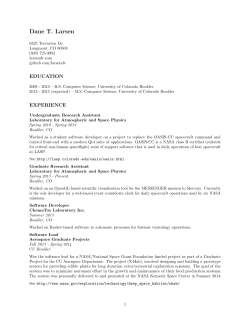
Strategy For Verification and Validation
Section P: Relevance to NASA Missions Lead Author: Amy Lo I. Introduction This section outlines New Worlds Observer’s (NWO) relevance to NASA’s strategic vision. We took as the basis for relevance comparison the Science Plan for NASA’s Science Mission Directorate (SMD) 2007 to 20161. We address mappings to SMD’s science goals, as well as how NWO will help develop SMD’s technology goals, and show how the mission supports SMD’s principles. II. Mapping to Science Goals NWO addresses a wide range of SMD’s Astrophysics goals. NASA’s Astrophysics Goals are summarized in Table 1. We address each topic and cite examples of how NWO will help answer these fundamental questions. With a starshade and a general astrophysics telescope, NWO can address more than half of these questions. Table 1: NASA Astrophysics Target Goals Through 2016 1. What are the Origin, Evolution, and Fate of the Universe? 1 http://nasascience.nasa.gov/about-us/science-strategy NWO addresses two of the five questions in this area using the capabilities enabled by the 4 m telescope: Precisely determine the cosmological parameters governing the evolution of the universe. o The NWO telescope contains a sensitive wide field camera that can perform surveys of Visible and NIR galaxies to measure the geometry of the universe o Spectroscopic survey of emission line galaxies can obtain precise radial velocities to place them in 3-D space and identify the frequency of large scale structure due to primordial baryon acoustic oscillations. Improve our knowledge of dark energy, the mysterious cosmic energy that will determine the fate of the universe. o NWO can monitor hundreds of type Ia supernova at various redshifts out to z~2 to obtain precision measurements of the acceleration of the expansion of the universe. 2. How Do Planets, Stars, Galaxies, and Cosmic Structures Come into Being? NWO can address 5 of the 8 questions in this area. NWO’s 4m UV-Visible telescope is an excellent companion instrument for missions covering other wavelengths (such as JWST in the NIR and IR, and IXO in the X-ray) for Visual follow-ups of objects. Measure the distribution of dark matter in the universe o NWO will enable large surveys such as galaxy redshift surveys or weaklensing surveys. Trace the filamentary cosmic web of atomic matter in the universe o The 4 m UV-Visible telescope enables observations of Lyman-alpha forest and galaxy clusters with deeper and higher-resolution observations than HST. Determine the history of cosmic star formation and the assembly of galaxies o Surveys supporting the study of large scale structure, galaxy clusters, and star formation in the Milky Way will be part of NWO’s general astrophysics program. Study the birth of stellar and planetary systems o The 4m telescope and studies of planetary systems enabled by the Starshade will give unprecedented information regarding the composition, abundance, and density of interstellar gas, circumstellar disks, and stars in all phases of formation. Uncover the connection between galaxies and super-massive black holes o NWO can measure velocity dispersions in the centers of galaxies and warm dust around AGN. Starshade can be used to study the inner regions of AGN by blocking the inner bright portions. 3. When and How Did the Elements of Life and the Universe Arise? The NWO mission can address some of these questions by measuring emission or absorption lines of selected heavy elements. • Measure the metal enrichment of the diffuse intergalactic and interstellar media. • o NWO can accomplish this by observing absorption lines in intergalactic and interstellar media across the UV-Vis wavelength range to determine abundances and densities. Improve our understanding of supernovae and their nucleosynthesis of heavy elements needed for life. o NWO enables sky monitoring, which can be done simultaneously with the exoplanet observations (which use a different instrument). This will allow us to have wide and deep fields to observe supernovae and their remnants. Follow up observations can obtain spectra to identify elements produced. 4. Is There Life Else-where? The NWO mission is designed to answer this question, and can fully address this issue. • Determine the frequency with which planets are found within the habitable zones of other stars and characterize their physical properties, such as mass, diameter and orbital parameters. o NWO will survey nearby stars to determine earth. Combined with results from Kepler and Corot, a census of planets in the habitable zone will emerge. In addition, NWO can determine in the first visit, much of the physical properties of the planet such as the atmospheric constituents. Because it has no outer working angle, the inclination of the exo-solar system can be obtained and information such as the orbit can be inferred in approximately 3 revisits. • Determine what properties of a star (such as metallicity) are most strongly correlated with the presence of habit-able Earth-like planets. o An integral field spectrometer will enable NWO to obtain spectra of all objects in a particular solar system. Having found a significant number of planets, NWO can begin to correlate properties of the host star with the metallicity of its circumstellar disks and planets, enabling a coherent picture of planet formation to emerge. III. Mapping to Technology Goals NWO address many of the technology goals that NASA is seeking to develop to enable high-quality future astrophysical observatories. NWO is timely, as most of the pieces of the technology development we require are already in hand. This means NWO can be executed in a timely fashion, without the length technology development process that “new” technologies require. However, since it extends the use of existing technology, NWO still enables NASA to stretch its technology development “muscle”. This combination of qualities is ideal in the current fiscal climate. Furthermore, NWO is an extensible technology; our mission enables the timely development and qualification of a 4m telescope, and supports the development of large deployable space structures, key to both NASA’s future science and exploration goals. NWO’s mapping to selected key technology development goals: New remote sensing technologies to better see, detect, and measure the Earth, the sun, the solar system, and the universe o NWO supports this development by advancing the starshade technology. Starshades enable high contrast imaging without modifications to the accompanying telescope, enabling the telescope to be a more general astrophysical instrument. Starshades can be used across a broad range of telescopes, from UV to near-IR, allowing for monolithic, segmented, and distributed telescope architectures. Large, lower-cost, lightweight mirrors and space-Deployable Structures for the next generation of large telescopes and antennas o NWO supports the development and fabrication of a low cost, high quality 4m astronomical telescope. This development process will allow future space telescopes to leverage learning to build larger or distributed UVVisible telescopes. o NWO supports the development of space deployable structures by the design and fabrication of a 62m tip-to-tip starshade. This development includes lightweight structures, precision structure deployment, and onorbit control. It will enable NASA to have technology on hand to support a wide variety of structures such as ultra-large telescope baffles, solar sails, and other high precision deployables. Novel platforms, including power and propulsion technologies, that can take instruments to new vantage points o NWO will be using the NEXT propulsion system, along with a 18kW power system. Our current design leverages the systems developed for the Orion spacecraft, and brings technology developed for human spaceflight to support astrophysics discoveries. Successful development and validation of the NEXT system will allow future spacecrafts to go further while carrying less mass. This directly supports objectives of other NASA branches such as planetary sciences that need high efficiently in space propulsion. Intelligent distributed systems that enable advanced communications, efficient data processing and transfer, and autonomous operations of land- and spacebased assets o NWO takes the first steps towards a distributed system for trajectory and alignment control, by placing our alignment system on two spacecrafts. NWO will develop the control algorithms necessary for formation flying along the line of sight to within 1m. Development of this capability is the ideal first step for NASA’s goal of formation flying distributed apertures, as the large separation between the telescope and starshade prevents the spacecrafts from colliding with each other, yet the precision required is challenging enough to allow real advancements in technology. Information synthesis to derive useful knowledge from extremely large data sets through visualization, advanced simulations, analysis, and seamlessly linked models o NWO relies on advanced simulations linking real data from testbeds to simulations. NWO will develop seamlessly linked models such as those needed for the trajectory and alignment control that not only model disparate entities on a single spacecraft, but also straddles information between the two. Software and architecture developed for NWO will benefit future generations of spacecrafts that can leverage the highly synchronized communication between the telescope and starshade. In short, in one mission, NWO supports all of the key technology developments as identified in this strategic roadmap. IV. Mapping to SMD Principles NWO fully supports and is consistent with the principles that guide the goals of the SMD. Investment choices first consider scientific merit. o As demonstrated above, NWO fulfills over 80% of NASA’s astrophysics roadmap goals in addition to directly supporting NASA’s technology development strategy and partnership goals. Active participation by the research community outside NASA is critical to success o NWO is composed of a consortium of NASA, Academic, and industry partners working together to further a common scientific goal. NWO’s science team brings together scientists from US and foreign universities, as well as researchers from various NASA centers and non-profit research organizations such as Global Science Institute, where the study Lead Scientist is based. NWO technology team encompasses NASA centers, industrial sectors (such as NGC for the deployment of the starshade) and DOD entities (such as USNO for the development of the astrometric camera). All of this enhances the community and broadens the support base for NASA’s science. o NWO is working actively with foreign institutions to develop partnership strategies for enhanced international collaboration and cost sharing. The pace of scientific discovery is fueled by prompt, broad, and easy access to research data. o The NWO project has been very transparent and open with its study results, and we welcome collaboration with many institutions. The NASA mandate includes broad public communication. o The NWO project has set up Wiki pages and websites to allow the dissemination of project findings. Project representatives have attended and presented at every American Astronomical Society meeting; all SPIE Astronomical Telescope meetings; and all AIAA Space meetings since 2005 during which we presented over 20 papers, more than 20 posters, and over 15 talks. We have also actively engaged the public in various media including radio, television, and internet. Sustained progress in advancing U.S. space and Earth science interests requires investments across a broad range of activities. o The NWO concept brings together disparate sectors of technology both within and external to NASA and its programs.
© Copyright 2025









